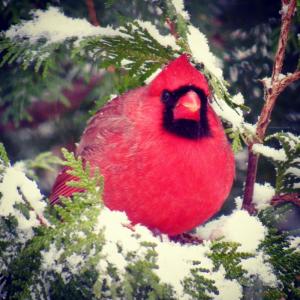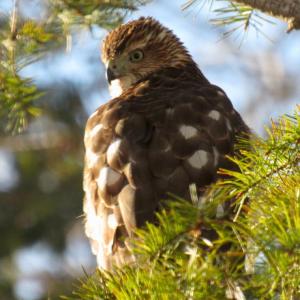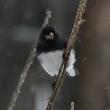Kristen Lindquist: Feeding the wild birds this winter
 The male cardinal awaits his turn at the feeder. Cardinals are always the first and last visitors at our feeders each day. (Photo courtesy Kristen Lindquist)
The male cardinal awaits his turn at the feeder. Cardinals are always the first and last visitors at our feeders each day. (Photo courtesy Kristen Lindquist)
 A Tufted Titmouse makes off with a black-oil sunflower seed. (Photo courtesy David Huddle)
A Tufted Titmouse makes off with a black-oil sunflower seed. (Photo courtesy David Huddle)
 An American Goldfinch in winter plumage visits the Nyjer feeder. (Photo courtesy David Huddle)
An American Goldfinch in winter plumage visits the Nyjer feeder. (Photo courtesy David Huddle)
 This junco prefers wild seed, as here, but will also visit feeders.(Photo courtesy David Huddle)
This junco prefers wild seed, as here, but will also visit feeders.(Photo courtesy David Huddle)
 This young Cooper’s Hawk kept a close eye on our bird feeders for one day last winter. (Photo courtesy Kristen Lindquist)
This young Cooper’s Hawk kept a close eye on our bird feeders for one day last winter. (Photo courtesy Kristen Lindquist)
 The range of the Carolina Wren has been moving steadily northward and more are staying in Maine for the winter. High energy food like peanuts will help keep them alive. (Photo courtesy Don Reimer)
The range of the Carolina Wren has been moving steadily northward and more are staying in Maine for the winter. High energy food like peanuts will help keep them alive. (Photo courtesy Don Reimer)
 This Bullock’s Oriole, a rare visitor to Maine from west of the Rockies, was sustained through the winter a few years ago by high quality food at the homeowner’s feeders, including fruit and mealworms. (Photo courtesy Don Reimer)
This Bullock’s Oriole, a rare visitor to Maine from west of the Rockies, was sustained through the winter a few years ago by high quality food at the homeowner’s feeders, including fruit and mealworms. (Photo courtesy Don Reimer)
 The male cardinal awaits his turn at the feeder. Cardinals are always the first and last visitors at our feeders each day. (Photo courtesy Kristen Lindquist)
The male cardinal awaits his turn at the feeder. Cardinals are always the first and last visitors at our feeders each day. (Photo courtesy Kristen Lindquist)
 A Tufted Titmouse makes off with a black-oil sunflower seed. (Photo courtesy David Huddle)
A Tufted Titmouse makes off with a black-oil sunflower seed. (Photo courtesy David Huddle)
 An American Goldfinch in winter plumage visits the Nyjer feeder. (Photo courtesy David Huddle)
An American Goldfinch in winter plumage visits the Nyjer feeder. (Photo courtesy David Huddle)
 This junco prefers wild seed, as here, but will also visit feeders.(Photo courtesy David Huddle)
This junco prefers wild seed, as here, but will also visit feeders.(Photo courtesy David Huddle)
 This young Cooper’s Hawk kept a close eye on our bird feeders for one day last winter. (Photo courtesy Kristen Lindquist)
This young Cooper’s Hawk kept a close eye on our bird feeders for one day last winter. (Photo courtesy Kristen Lindquist)
 The range of the Carolina Wren has been moving steadily northward and more are staying in Maine for the winter. High energy food like peanuts will help keep them alive. (Photo courtesy Don Reimer)
The range of the Carolina Wren has been moving steadily northward and more are staying in Maine for the winter. High energy food like peanuts will help keep them alive. (Photo courtesy Don Reimer)
 This Bullock’s Oriole, a rare visitor to Maine from west of the Rockies, was sustained through the winter a few years ago by high quality food at the homeowner’s feeders, including fruit and mealworms. (Photo courtesy Don Reimer)
This Bullock’s Oriole, a rare visitor to Maine from west of the Rockies, was sustained through the winter a few years ago by high quality food at the homeowner’s feeders, including fruit and mealworms. (Photo courtesy Don Reimer)
You may have seen a recent report that bird populations have declined by over 3 billion birds, or by almost 30%, in the past fifty years. It’s not surprising: Birds run a daily gauntlet that includes pet cats, window collisions, habitat loss, and climate change. Thanks to global warming, in a few decades we might not even see chickadees at our bird feeders here in Maine anymore! So setting up a feeder or two in the yard, or adding another feeder to a current setup, seems like the least we might do to help out our feathered friends during the cold and snowy winter months ahead.
Feeding birds helps them get through a tough season. And the daily sight of birds might help get you through a tough season. I love looking out my kitchen window on a winter’s day to see “our” pair of cardinals framed in snow in the cedar hedge, waiting their turn at the feeder. Before you know it, you’ll be as familiar with your local birds’ habits as you are with those of your human neighbors.
And don’t worry, wild birds don’t become dependent on what you’re offering. When you leave for your week in Florida, the cardinals won’t starve without you. Feeders merely supplement the natural food birds find in the wild. When natural food sources are abundant, such as when wild plants go to seed in the fall, you won’t see many birds at your feeders. But when these resources are buried in snow and ice, those fickle creatures will start showing up again.
Most birds will eat what Birdwatcher’s Digest calls “the hamburger of the bird world”: Black-oil sunflower seed. As compared to the striped sunflower seed, black-oil seed has a higher fat content, which is especially beneficial in winter, and a thinner shell that most birds can open. The mix we use in our window feeders is predominately black-oil sunflower seed, and it seems to draw in everyone from chickadees, titmice, and cardinals to goldfinches, House Finches, and White-breasted Nuthatches.
Derek Lovitch, owner of Freeport Wild Bird Supply in Freeport, advocates for a black-oil sunflower seed mix rather than straight black-oil. As he puts it: “Black-oil is the favorite seed of most feeder birds, but how often would you go to your favorite restaurant if there was only one thing on the menu?”
And if buying local is important to you, Freeport Wild Bird Supply, now offers bags of high-quality black-oil sunflower seed from a farm up in Aroostook County.
The seed mix I use also contains shelled peanuts, another great, high-energy option. Most of our birds love peanuts, but usually the Blue Jays get to them first. A jay will hang off the feeder and pick out one peanut after another, then fly off with a bulging crop, intending to cache most of them. I don’t mind: the jays are beautiful in the snow, and their brassy personalities liven up the yard.
In addition to a handful of window feeders, we also hang up suet. Nothing beats a block of pure fat for providing winter fuel. Three different species of woodpecker regularly visit our suet in the winter—Downy, Hairy, and Red-bellied—as well as the nuthatches and jays. And if one or two Carolina Wrens are lingering in the neighborhood, as has happened in winters past, they might peck at it, as well.
A tube or sock feeder filled with Nyjer (also called thistle seed) will attract goldfinches, Pine Siskins, and their finch friends. A tube feeder bedecked with colorful finches can be a festive sight. Nyjer is rich in fat, protein, and fiber—just what these little birds need to survive the winter weather.
If you’re one of the lucky few who have bluebirds in your yard in the winter, you might also consider putting out mealworms for them.
One more thing to keep in mind about bird seed: quality matters. You get what you pay for. That big bag that you got for cheap in the discount store undoubtedly contains a lot of poor-quality filler and was probably stale. And the birds will notice. As Derek says, “Buying seed in bulk doesn’t save you any money if the birds won’t eat it!”
If you see birds around but not on your feeder, try a different, hopefully better quality, seed.
Birds will rightfully disdain rancid seed, as well. Keeping feeders clean is a vital component of feeding birds, in any season, and simply requires hot water and soap. Even in cold weather a dirty feeder can become a hub of disease transmission, especially eye infections among finches. If you do spot infected birds on your feeders, for the health of the birds take all your feeders down, clean and disinfect them thoroughly, then wait a few weeks before putting them back up.
Birds that feel too exposed at a feeder won’t risk visiting, so placement is key. Siting it near the cover of trees and shrubs will help prevent your songbird feeder from becoming a hawk feeder. Brush piles ten feet or so from the feeders will also offer protection. And if the occasional hawk does stop by for a visit, just remind yourself that they’re also struggling for survival in winter. The mortality rate of young hawks in their first year is well over 50% for most species.
And finally, that elephant in the room: squirrels. Derek says that the bulk of the bird-feeding queries his store receives have to do with squirrels and how to keep them off feeders. He asserts: “There are millions of ways to try and outsmart squirrels, but only a few ways that will actually work, because squirrels are smarter than you when it comes to feeders.” He recommends squirrel baffles on properly sited pole feeders.
Whether you manage to outsmart the squirrels or not, your efforts on behalf of the birds this winter just might provide that little boost some of them need to survive until spring.
Kristen Lindquist is an amateur naturalist and published poet who lives in her hometown of Camden.

Event Date
Address
United States







































